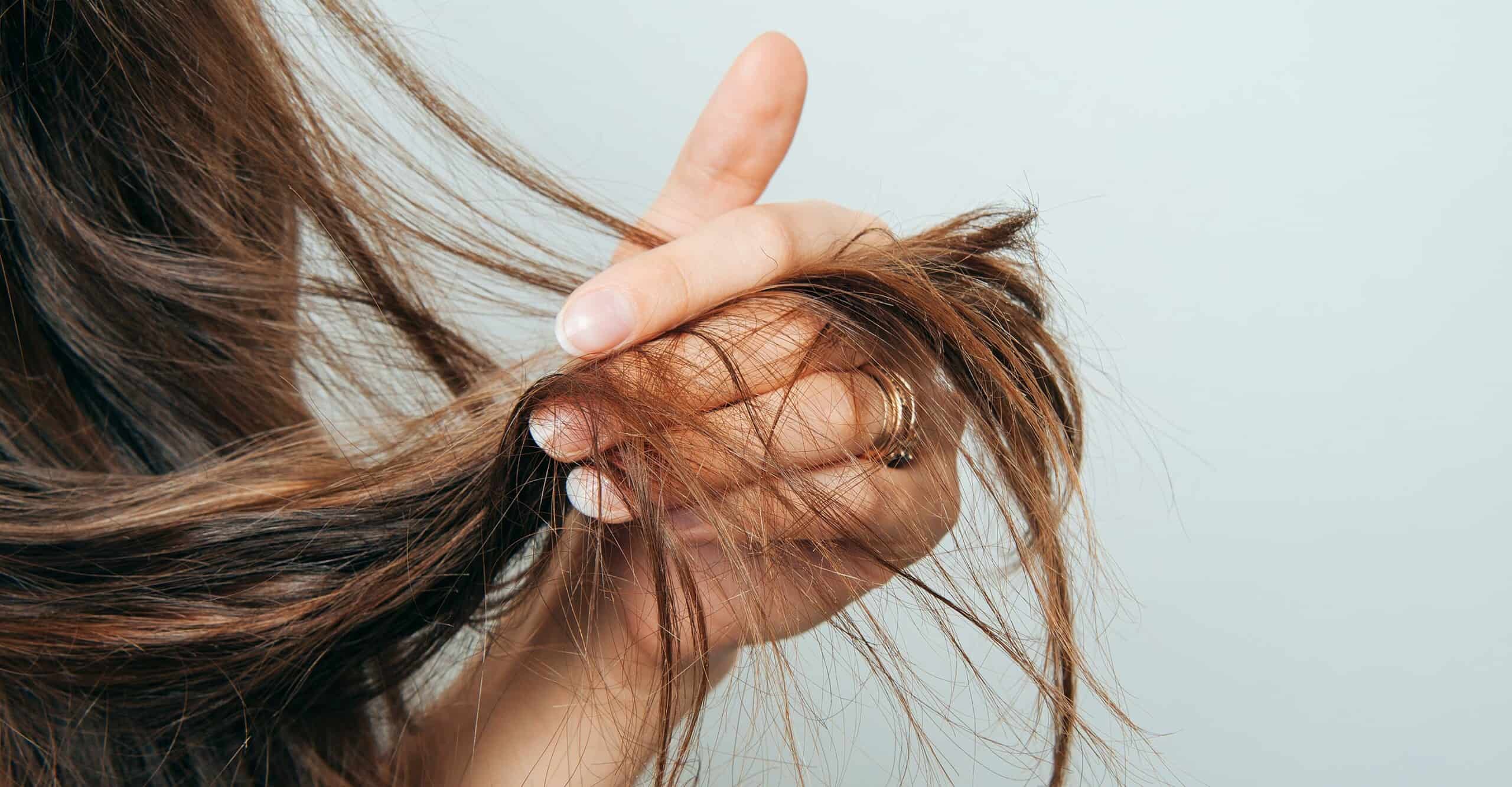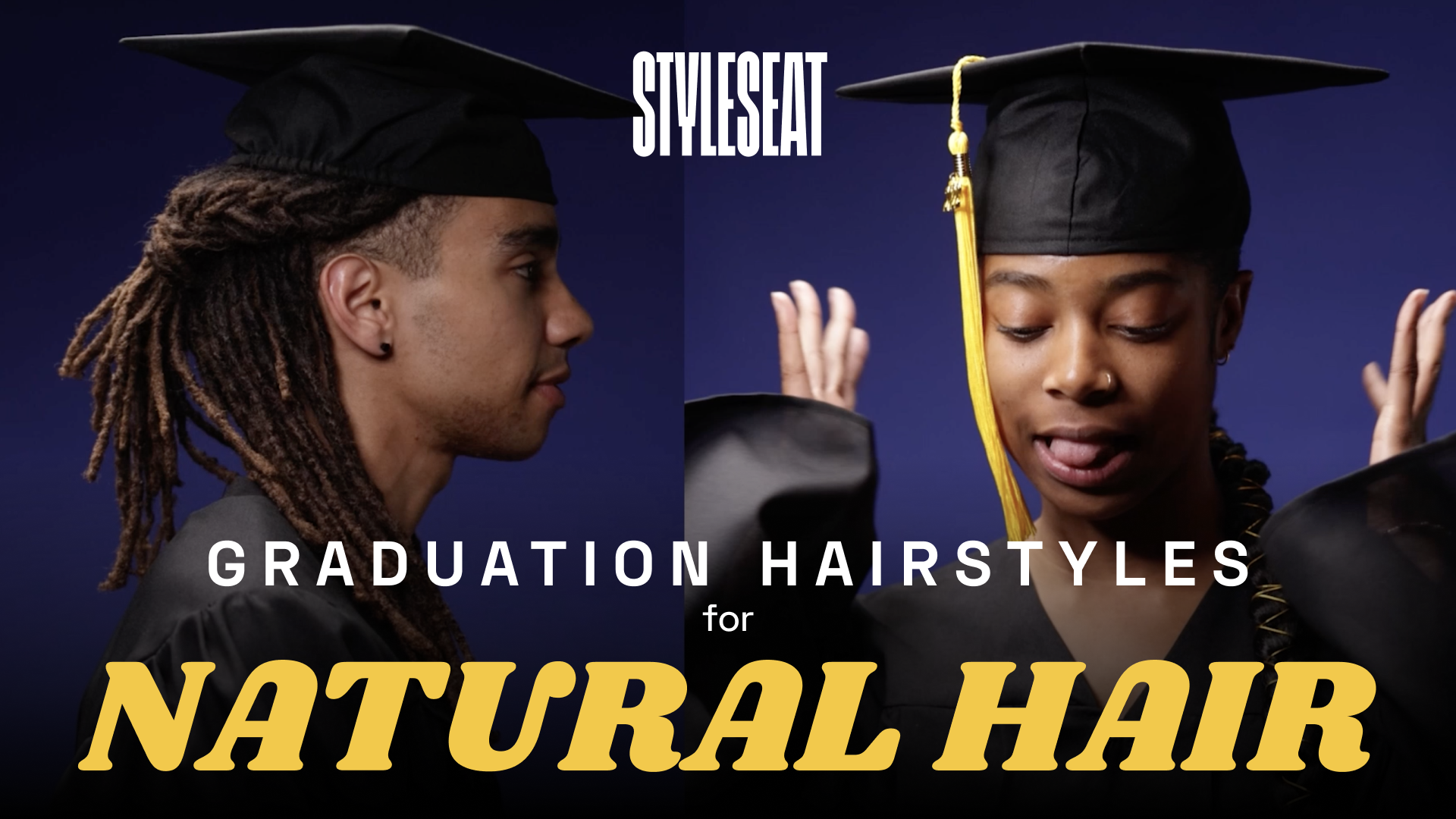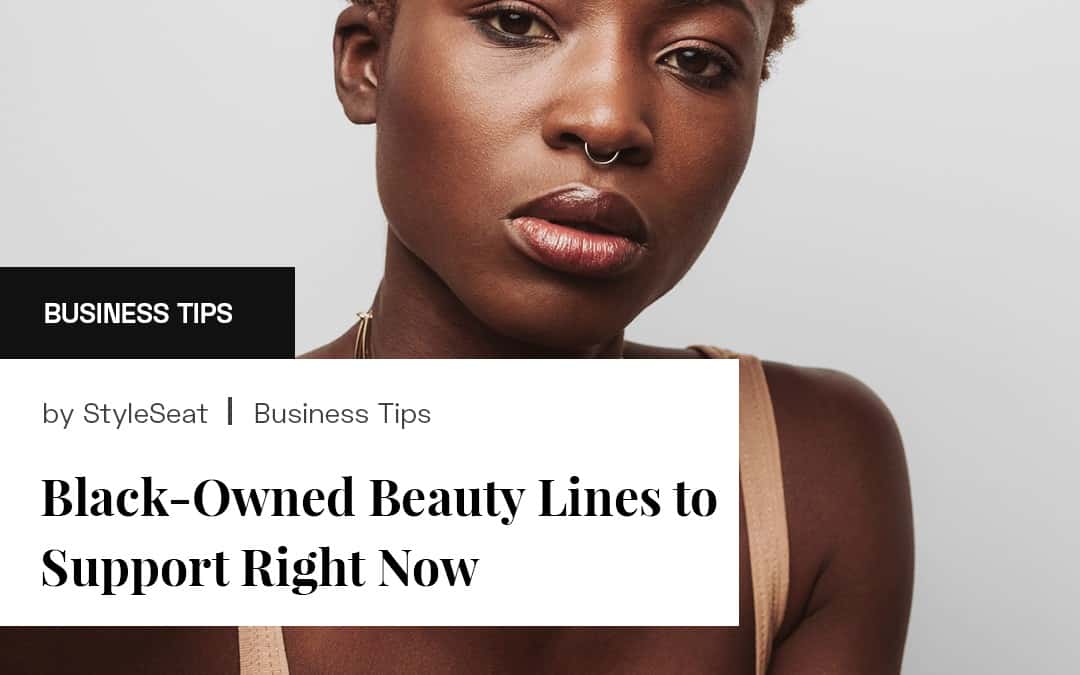Unraveling the History of Black Hair: Hair, Culture, and Identity in America
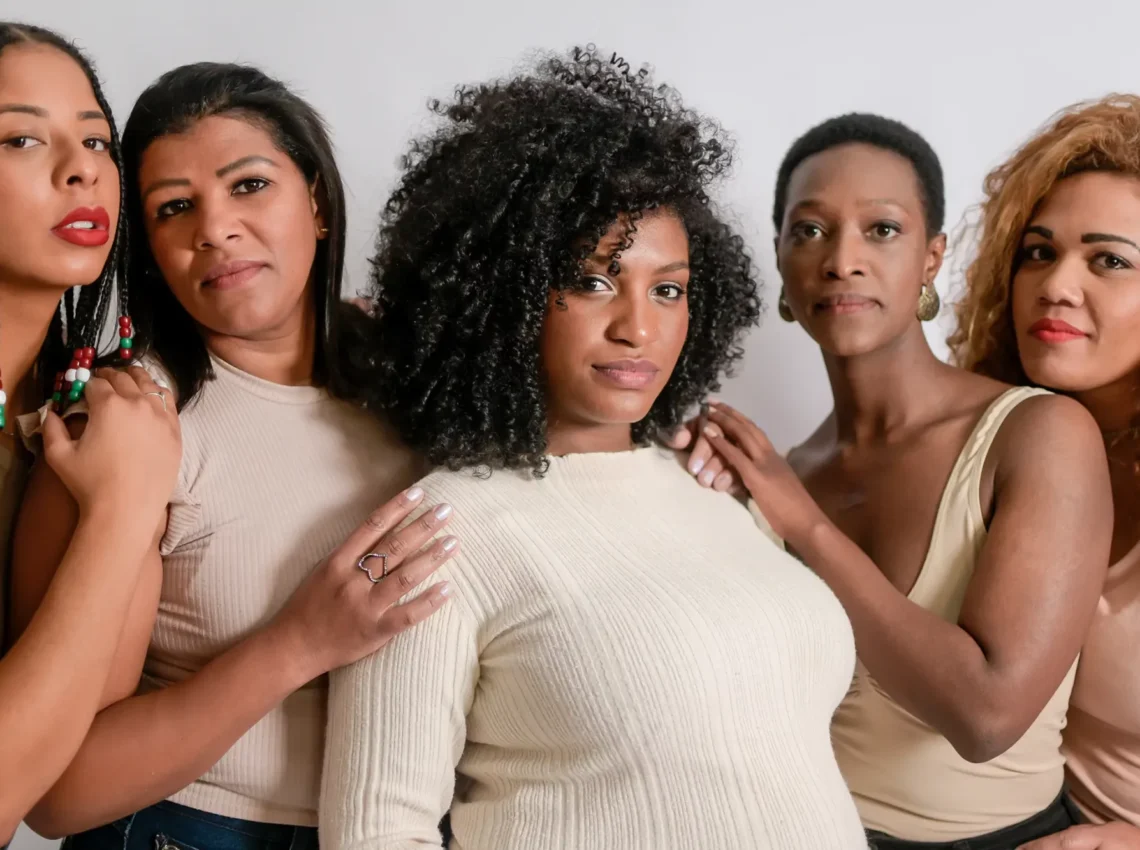
It seems like Black hair is always in the news, and we’re constantly hit with reports on celebrity fashion commentary or hair discrimination in the workplace. The history of Black hair goes back as far as the history of the human race, but not everyone knows how important it is to learn about the history behind Black hairstyles.
Black hair allows for so much versatility, whether you’re committed to your silk press, love your locs, or prefer to switch it up. Especially today, it’s important for people of all races to know the history behind Black hair. When it comes to the freedom to wear your style without the stigma, hair is more than just hair.
Keep reading to learn more about the history of Black peoples’ hair and the iconic moments that changed style history.
Black hair and identity
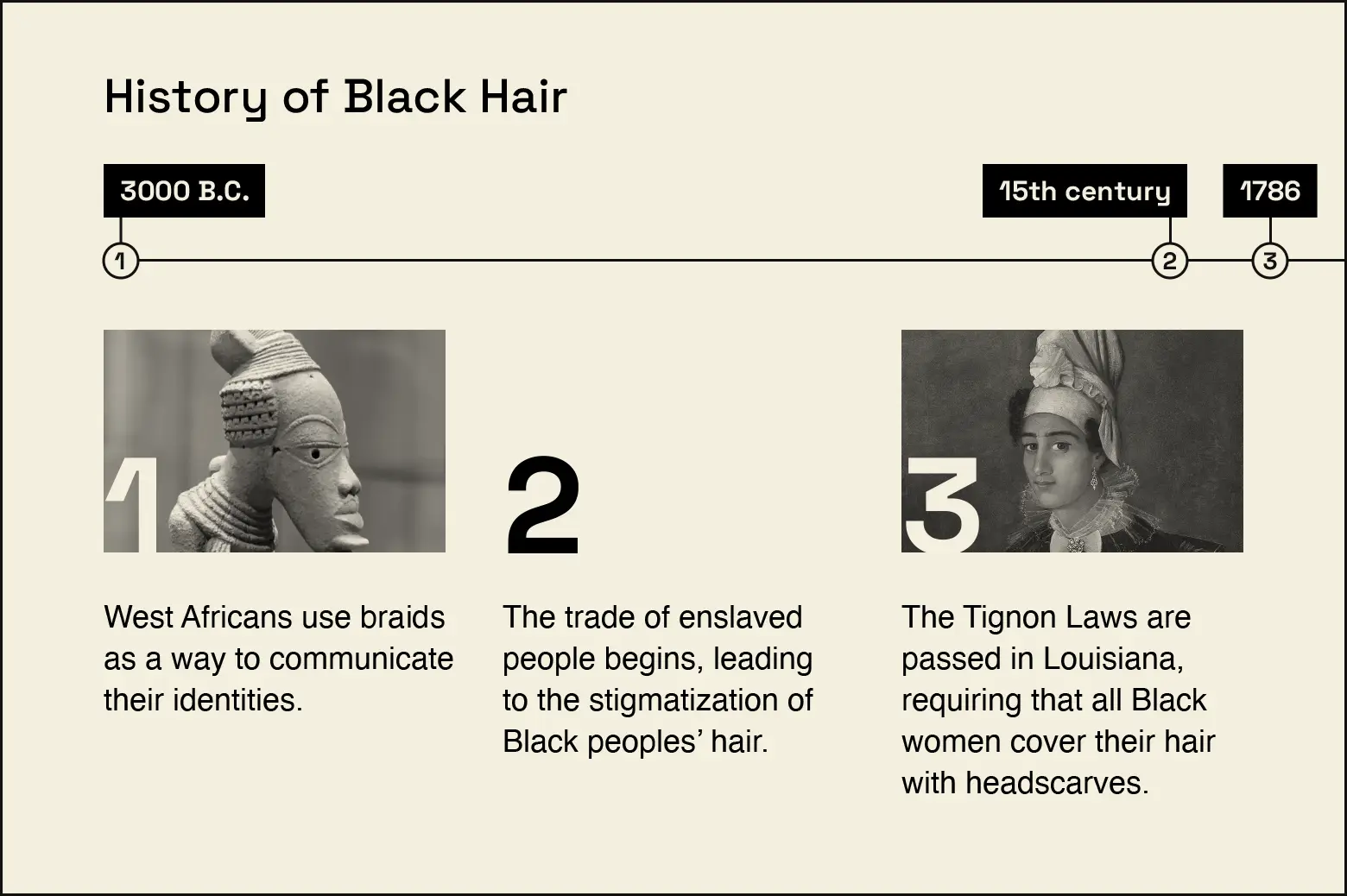
Tignon Laws Painting: The Historic New Orleans Collection via Wikipedia
Key Moments:
- 3000 B.C.: West Africans use braids as a way to communicate their identities.
- 15th century: The trade of enslaved people begins, leading to the stigmatization of Black peoples’ hair.
- 1786: The Tignon Laws are passed in Louisiana, requiring that all Black women cover their hair with headscarves.
When we talk about the history of Black hair in America, the roots of this history are actually in Africa. When enslaved people were brought to the Americas, they brought the culture of their hair with them. Black hairstyles were part of Black identity, so it’s no surprise that these styles stuck around when people were removed from their homes, families, and culture.
Pre-colonial era: African roots and the trade of enslaved people
The way Black people wear their hair has always been meaningful. Throughout Africa, braided styles were a way of communicating key information to others without uttering a word. Particularly in West Africa, different hairstyles communicated:
- Familial ties
- Social status
- Tribal affiliation
- Marital status
- Occupation
Because of this, Black hairstyles have always been more than just a cosmetic trend. As the trade of enslaved people began, many Black people were forced to shave their heads or remove the hairstyles that were important to their identities. Black hair textures and styles were then heavily stigmatized as a way to dehumanize Black people.
1786: Tignon Laws are enacted
Despite the stigma, Black women continued to use their hair to express themselves. Just like today, they experimented with new styles of braids, gems, and beads. This was perceived by white people as both an act of defiance and a way to tempt men, which led to the passage of the Tignon Laws in Louisiana in 1786.
The Tignon Laws forced all Black women to hide their hair under headscarves. This restricted Black women’s self-expression and turned their hair into a symbol of their oppression. Black women fought against the Tignon Laws by choosing colorful scarves or adorning their scarves with beads and jewels until 1803 when the laws were repealed.
Origin of Black hair products
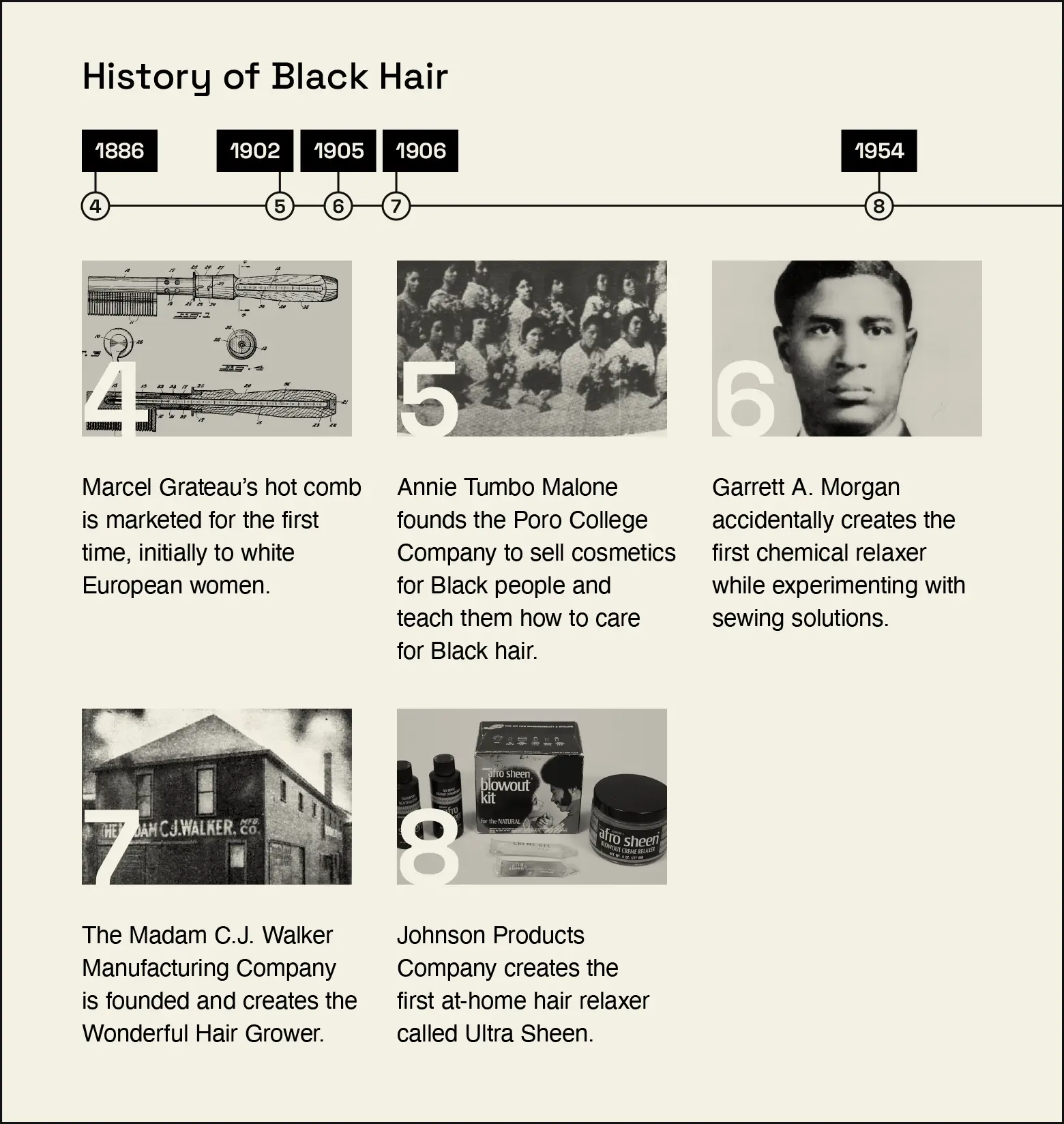
Poro College Co: Julius F. Taylor via Wikipedia
Garrett A. Morgan: US Department of Transportation via Wikipedia
Madam C.J. Walker: (Artist Unknown) via Wikipedia
Johnson Products: National Museum of American History via Wikipedia
Key Moments:
- 1886: Marcel Grateau’s hot comb is marketed for the first time, initially to white European women.
- 1902: Annie Turnbo Malone founds the Poro College Company to sell cosmetics for Black people and teach them how to care for Black hair.
- 1905: Garrett A. Morgan accidentally creates the first chemical relaxer while experimenting with sewing solutions.
- 1906: Madam C.J. Walker founds the Madam C.J. Walker Manufacturing Company and creates the Wonderful Hair Grower.
- 1954: Johnson Products Company creates the first at-home hair relaxer called Ultra Sheen.
For many years, you could walk into a store and find hair care products marketed to white and non-Black people of color, but nothing that was suited for the curls and coils of Black peoples’ hair. Scalp and hair issues were common in the Black community, which were both physically uncomfortable and impacted self-esteem. This was the motivating factor for many Black inventors who changed the cosmetics industry.
1886: The invention of the hot comb
For hundreds of years, businesses believed that there was no Black consumer market for hair products, tools, or cosmetics. When Marcel Grateau marketed the first hot comb in 1886, however, the beauty industry quickly learned it was wrong.
Though Grateau marketed the hot comb first, no one’s sure who truly invented it. It was originally marketed to white women who wanted to emulate the straight hair they saw in ancient Egyptian art, but Black people who straightened their hair quickly adopted the tool.
Many Black people straightened their hair in an effort to reduce the hair stigma that they otherwise experienced. Hot combs were a bit easier to use than the clothing irons people used before, and allowed women to more easily style their own hair.
The hot comb became one of the most iconic hair tools for the Black community. You can still find hot combs today, and they’re exactly what you’d think — heated combs that straighten hair as you brush it.
1902: Black hair products are first sold
Inspired by taking care of her sisters’ hair, Annie Turnbo Malone wanted to create a place where people could learn to care for Black women’s hair while providing the products to do so, and eventually founded Poro College Company. She was best known for the Poro Hair Grower and Special Hair Grower, but also sold makeup, wigs, hair wefts, and more.
Madam C.J. Walker got her start selling Poro College Company products, but eventually created her own. She was best known for Walker’s Wonderful Hair Grower, and eventually became the first self-made female millionaire in the United States. Both Walker and Malone used their wealth to become philanthropists, giving back significantly to their communities.
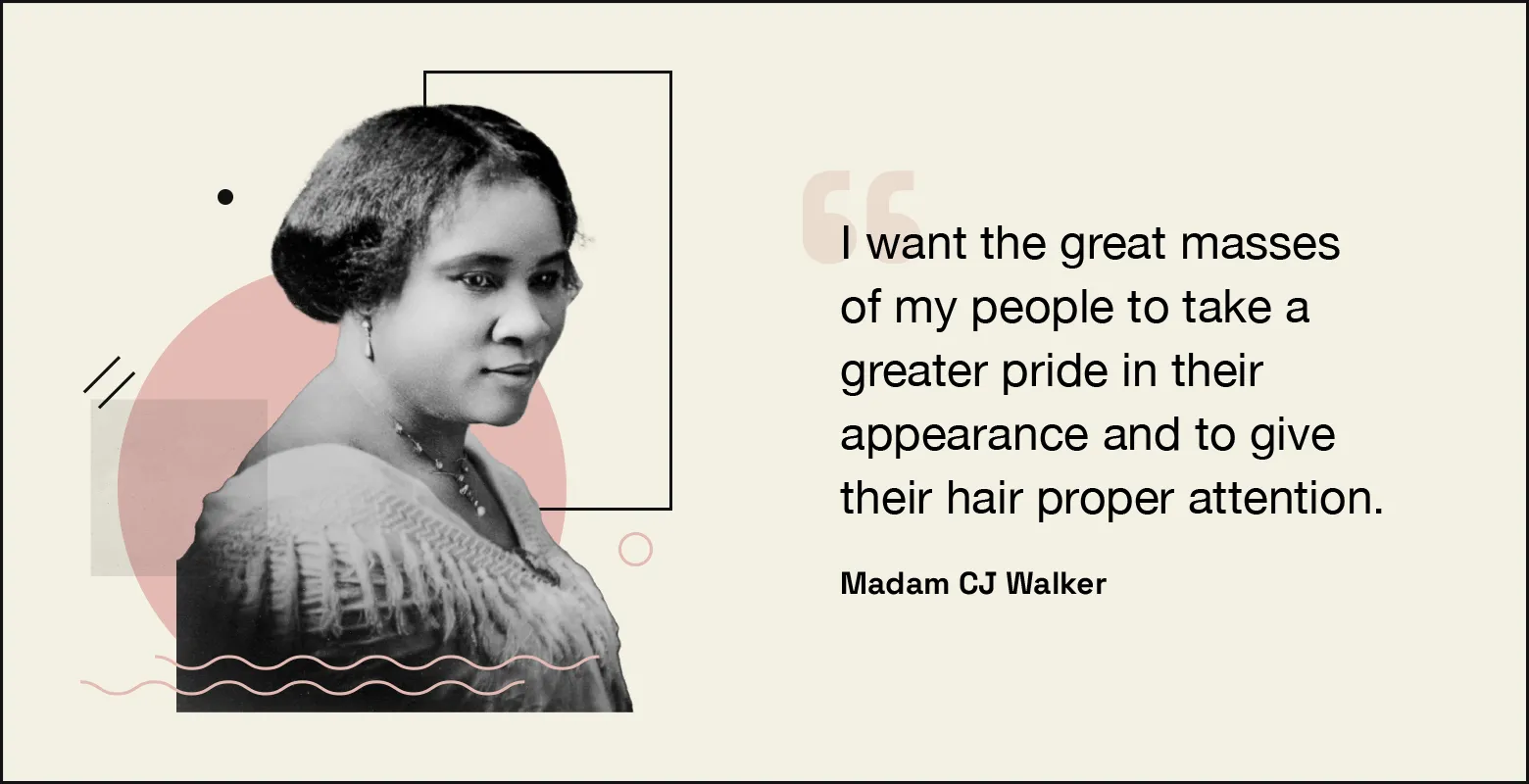
Though people have been straightening their hair for hundreds of years, there wasn’t a permanent solution until the 1900s. In 1905, a tailor named Garrett A. Morgan accidentally invented hair relaxer. He was experimenting with solutions to help needles glide through fabric better and instead discovered that it worked as a chemical hair relaxer.
When Morgan realized what he’d created, he established the G.A. Morgan Hair Refining Company and began selling his straightening cream. People who preferred straightening their hair headed to the salon, which saved them the time of styling their hair every day.
Forty-nine years later, Johnson Products Company released Ultra Sheen. This was the first at-home relaxer product, though many different kinds are found on shelves today. Johnson Products Company eventually became the first Black-owned company in the American stock exchange.
Reclaiming natural hairstyles
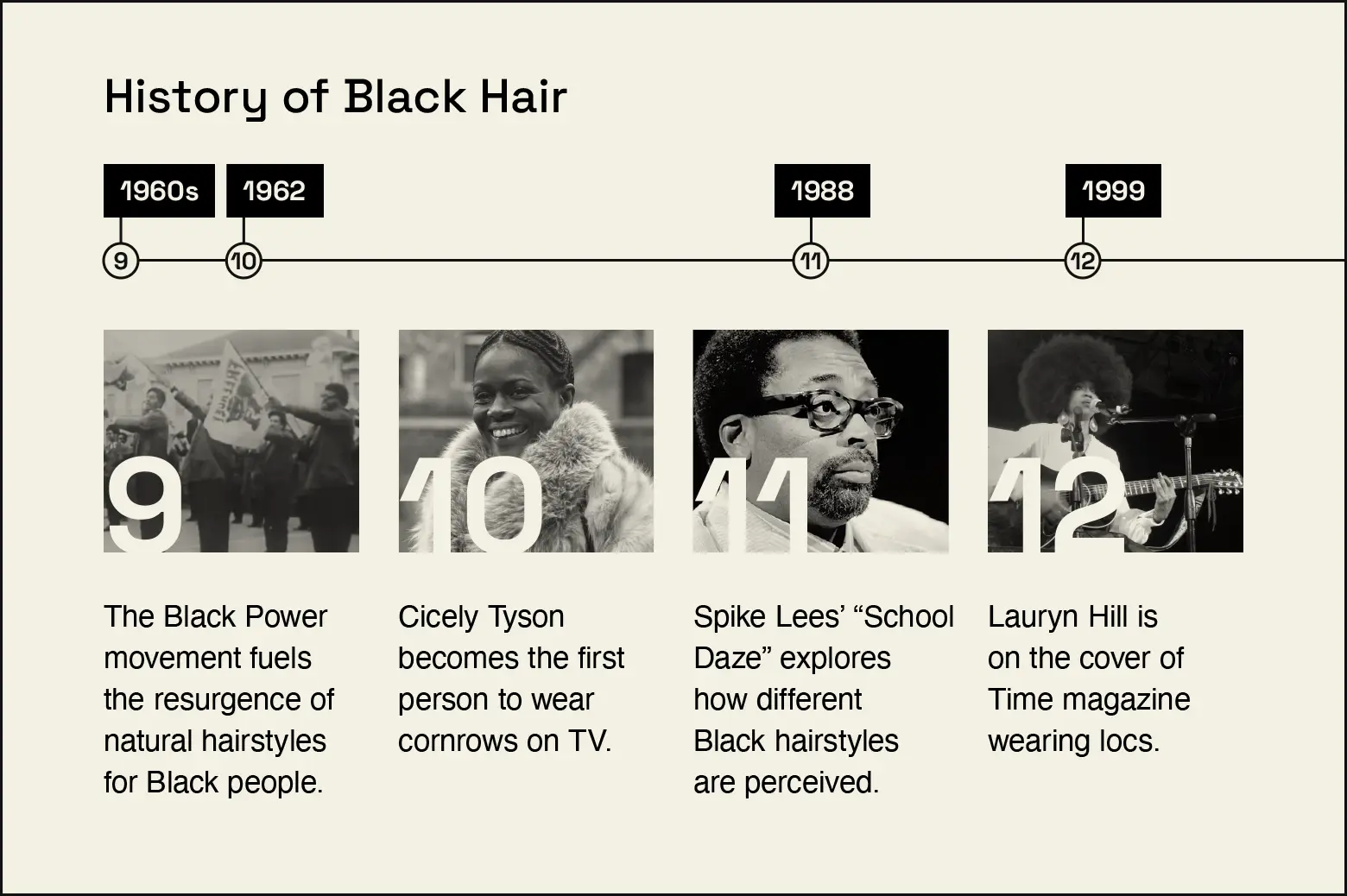
Cicely Tyson: Peters, Hans / Anefo via Wikipedia
Spike Lee: Hans Reitzema via Wikipedia
Lauryn Hill: Lisa Liang via Wikipedia
Key Moments:
- 1960s: The Black Power movement fuels the resurgence of natural hairstyles for Black people.
- 1962: Cicely Tyson becomes the first person to wear cornrows on TV.
- 1988: Spike Lee’s “School Daze” explores how different Black hairstyles are perceived.
- 1999: Lauryn Hill is on the cover of Time magazine wearing locs.
Black peoples’ hair, new hairstyles and movements have emerged to counteract hair stigma. For example, we previously discussed how Black women decorated their headscarves as a way to fight against the Tignon Laws that required them to cover their hair.
For many years, it was more socially acceptable for Black women to straighten their hair than to style it with its natural texture. Activists have always included conversations about hair stigma in their activism because stigma against natural hair is just one small part of the discrimination that Black people face every day.
“Hair is hair, yet also about larger questions: self-acceptance, insecurity, and what the world tells you is beautiful.”
— Chimamanda Ngozi Adichie
1960s: The rise of the Black Power movement
As the Black Power movement gained traction in the ‘60s, so did the conversation around wearing natural hairstyles. Though many activists wore afros, Angela Davis comes to mind for many when we think of this hairstyle. During this time, natural styles — the afro in particular — become countercultural symbols.
In 1962, cornrows were depicted on TV for the very first time. In the TV drama “East Side/West Side,” Cicely Tyson sported the traditional braid style for the world to see — a major step toward normalizing natural hairstyles. Tyson was the first Black person to star in a drama on American TV, and her braids became instantly iconic.
Though Tyson was the first Black woman to bring her natural hair to TV over six decades ago, there’s plenty of room for growth in how we view Black peoples’ hair in modern media. It still felt revolutionary to see Lauryn Hill grace the cover of Time magazine in 1999, wearing her signature locs. Throughout the ‘90s, Time only featured 18 Black cover stars (including Hill) out of over 500 issues of the magazine.
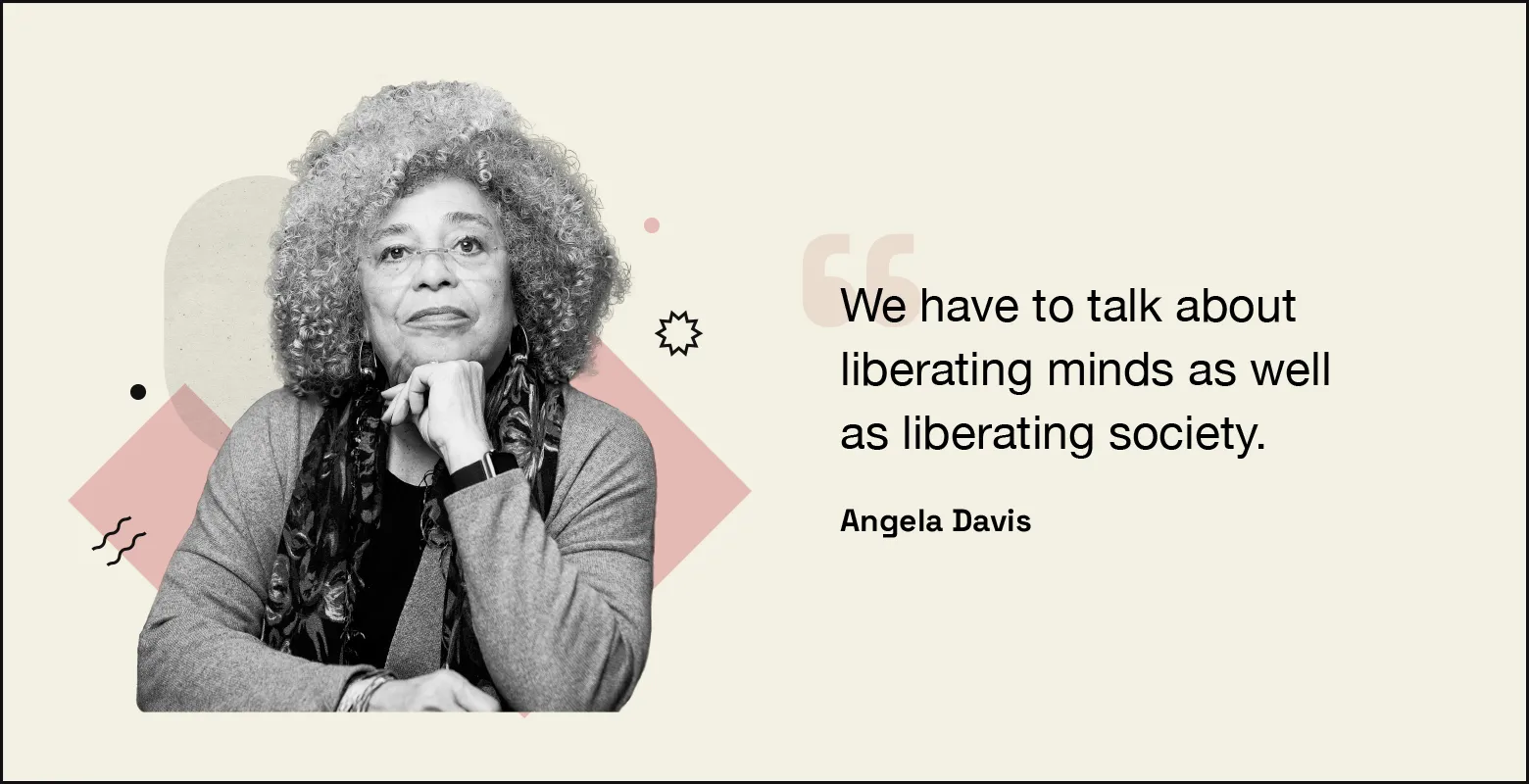
Some people might think that we’re only just starting to discuss the negative effects of hair stigma, but the truth is that people have been pushing back against hair stigma for as long as it has existed. From the Tignon Laws to the Black Power movement, hair stigma has always been part of the conversation.
In 1988, Spike Lee released the movie “School Daze,” touching on many important issues in the Black community. One of those topics was colorism and how the different ways Black people style their hair are met with different levels of stigma. This movie was groundbreaking in its honesty about hair stigma and was many viewers’ first introduction to the subject.
Pop culture and Black hair creativity
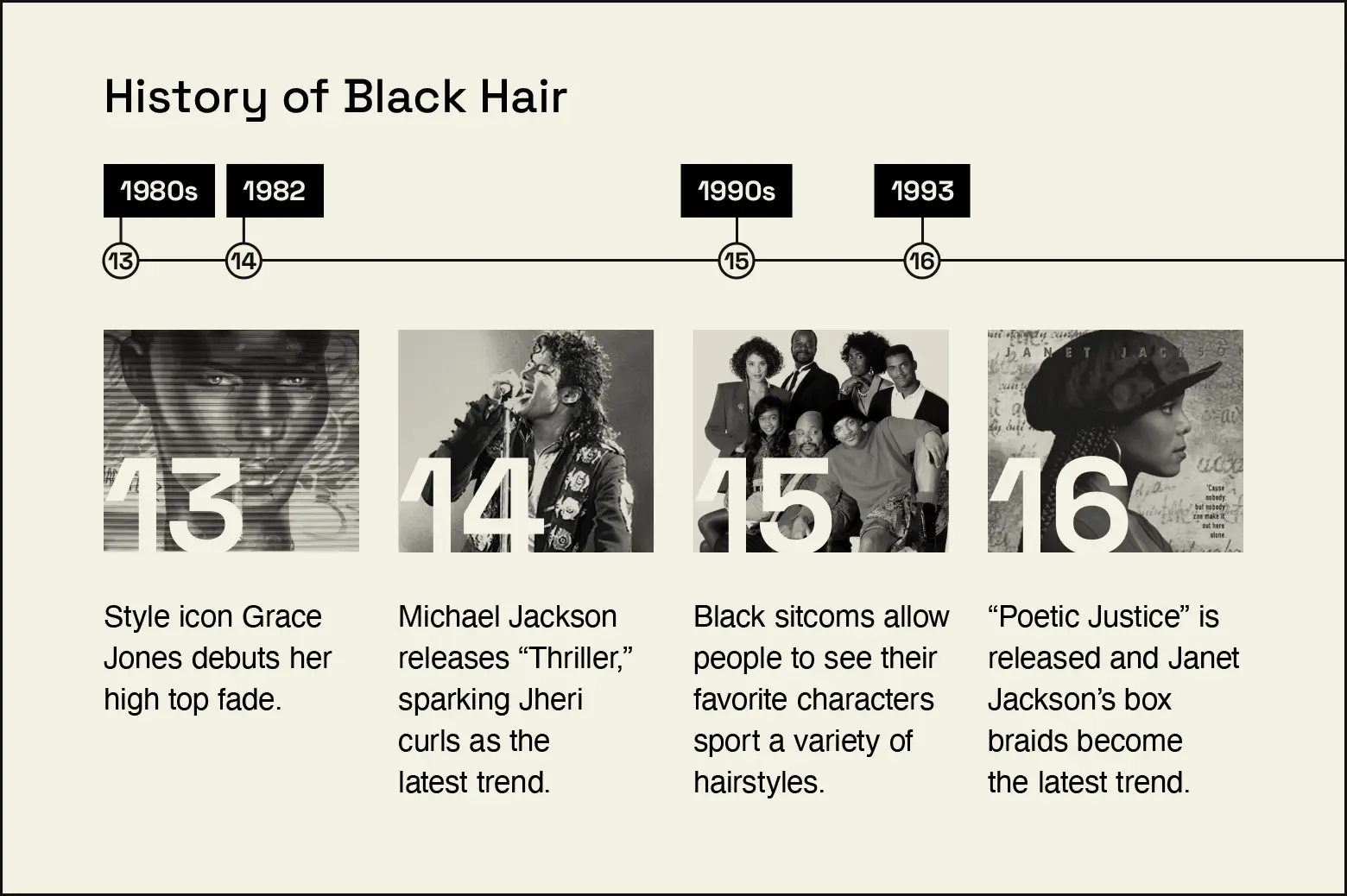
Michael Jackson: Zoran Veselinovic via Wikipedia
Fresh Prince: Fair Use
Poetic Justice: Fair Use
Key Moments:
- 1980s: Style icon Grace Jones debuts her high top fade.
- 1982: Michael Jackson releases “Thriller,” sparking Jheri curls as the latest trend.
- 1990s: The golden age of Black sitcoms allows people to see their favorite characters sport a variety of hairstyles.
- 1993: “Poetic Justice” is released and Janet Jackson’s box braids become the latest trend.
Mass media nurtures the spread of knowledge and ideas, so it’s no surprise that pop culture and TV all had a significant impact on Black hair trends.
“For young black girls, hair is not just something to play with, it is something that is laden with messages, and it has the power to dictate how others treat you, and in turn, how you feel about yourself.”
— Cheryl Thompson (Source)
1980s: Grace Jones debuts her high top fade
Many recognizable style moments from TV, movies, and music also influenced key hair trends for Black people from the 1970s and on. When Grace Jones added acting to her resume in the early ‘80s, she also started wearing her iconic high top fade.
Jones is an established editorial fashion expert — always sporting daring makeup and groundbreaking looks. She’s known for playing with androgyny in her fashion. The high top fade was a traditionally masculine look, but Grace Jones paved the way for other Black women to wear what they wanted, regardless of gender.
1982: Michael Jackson releases “Thriller”
For men’s hair, defined, tight curls called Jheri curls became all the rage. Jheri curls were invented by Irish-American hairstylist Jheri Redding in the ‘70s. This style didn’t truly explode until the early ‘80s, however, when Michael Jackson released “Thriller.” The iconic music video and album cover show off his coils and are a major reason this style became so popular among the Black community.
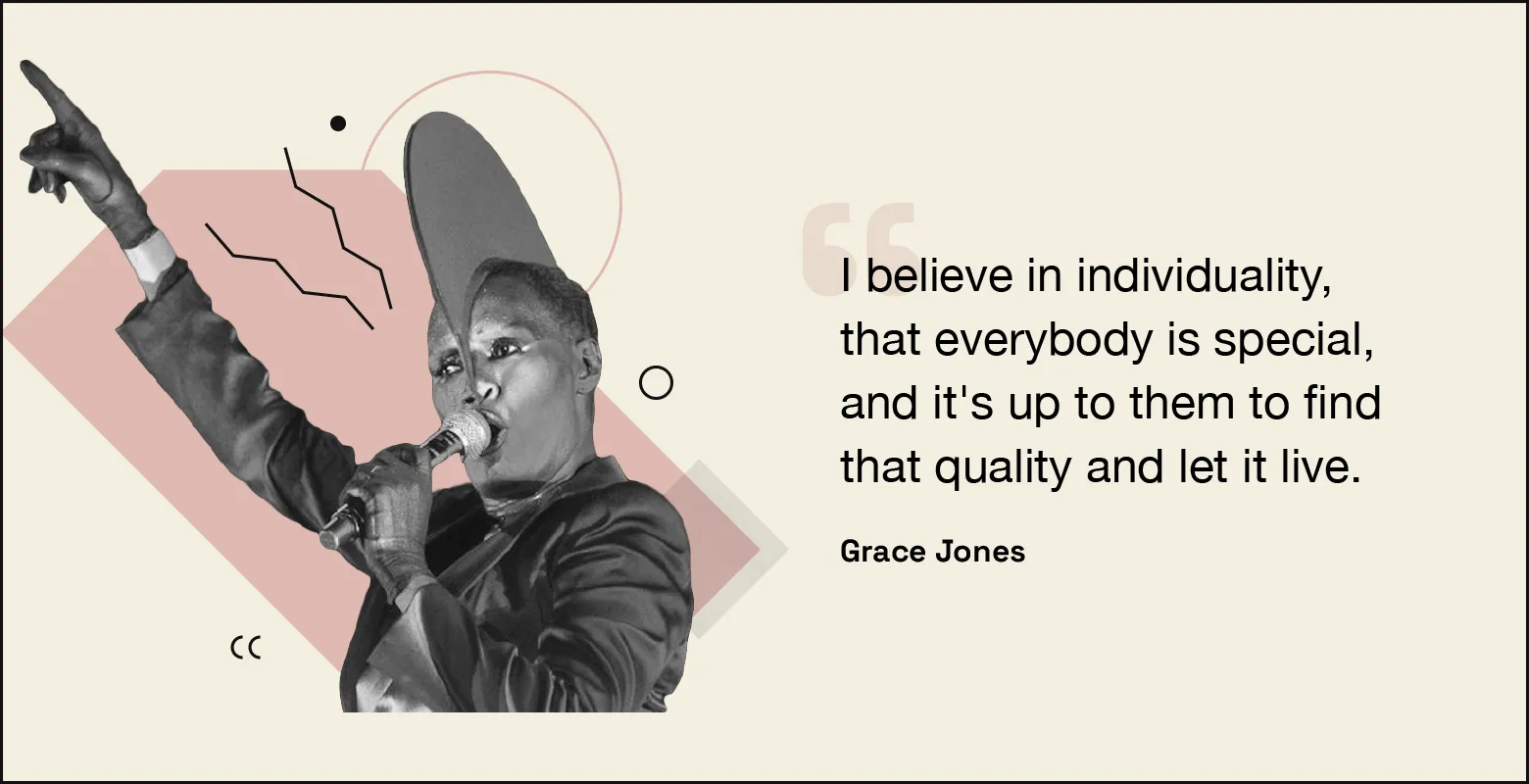
1990s and 2000s: The golden age of Black sitcoms
The next cultural wave came in the ‘90s and early 2000s, which was the golden age of Black sitcoms. Shows like “The Fresh Prince of Bel-Air,” “Moesha,” “Girlfriends,” and “Sister, Sister” were mainstream favorites across the country.
These sitcoms featured a range of Black hairstyles, from Brandy’s micro braids to the Mowry twins’ long curls. People watched their favorite characters switch up their hairstyles and evolve as the shows went on, finding new sources of hair inspiration.
Box braids also made a big comeback in the mid-‘90s and are still popular today. Many people attribute this to Janet Jackson’s character from “Poetic Justice.” Her long braids in the movie made audiences jealous and had women requesting similar looks in salons across the country.
“When my daughter became old enough, she wanted to have straight hair[…] and then I would find myself after I straightened her hair telling her to not do things that you would want kids to do. I would say, ‘Don’t run in water. Don’t jump in puddles.’[…] I could hear myself restricting her and taking away some of the freedoms that a child should have.”
— Angela Onwuachi-Willig (Source)
Natural hair in the 21st century
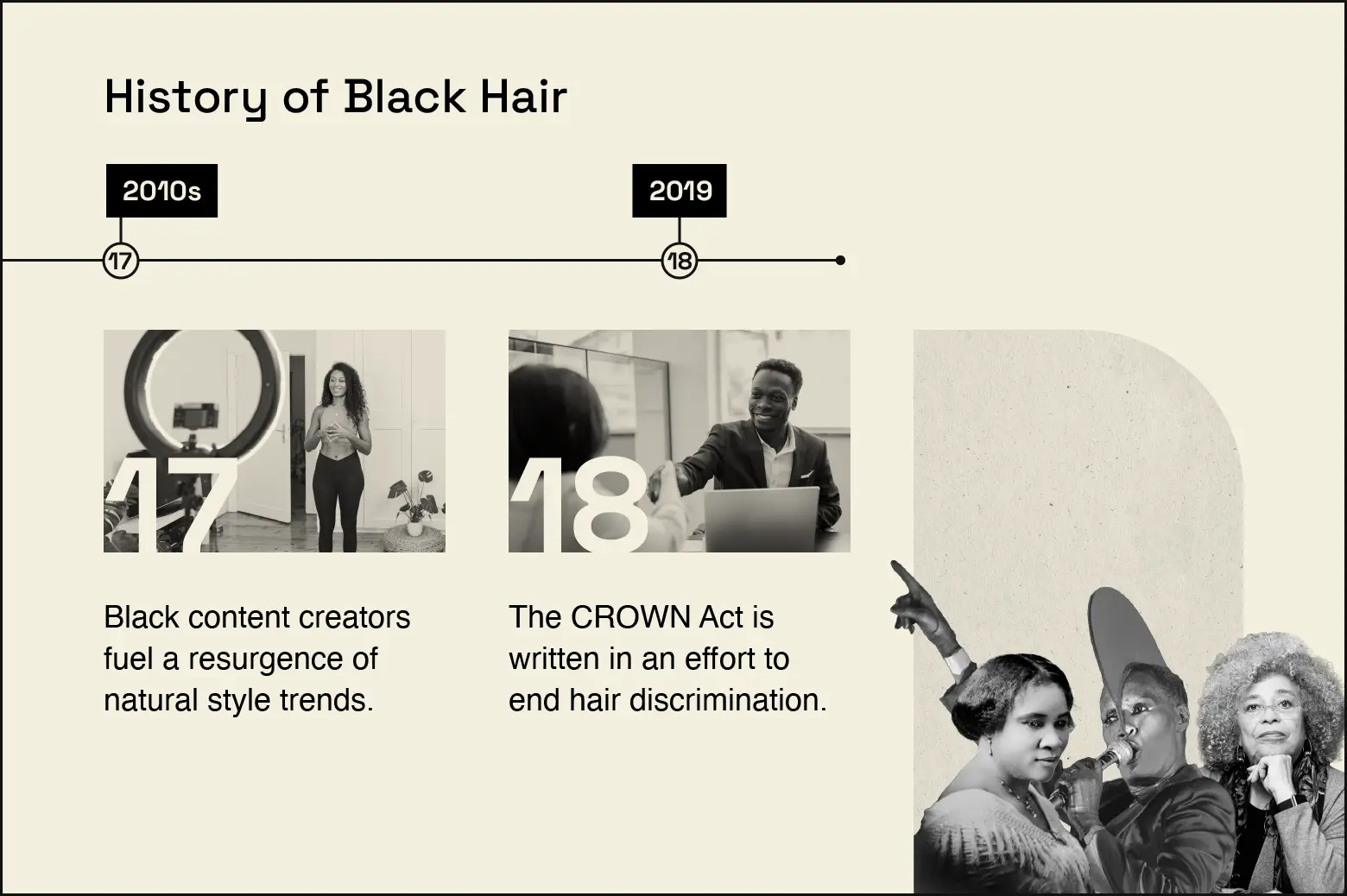
CROWN Act: FG Trade via Getty
Key Moments:
- 2010s: Black content creators fuel a resurgence of natural style trends.
- 2019: The CROWN Act is written in an effort to end hair discrimination.
With the internet and later the rise of social media, people encouraged and nurtured hair styling as a creative outlet. Black people experimented with mixing different braid styles, trying new hair colors, and accessorizing with beads and clips.
Black people could share their top tips, favorite products, and new styling ideas with people around the world. If someone wanted to learn anything about hair care or styling, they just had to drop a question on a forum and wait for the responses to roll in.
Though there were long-established braiding salon cultures in many cities, people struggled to find them in more rural areas, which made the internet a valuable tool for learning about hair. As more people became educated on caring for natural hair, it became easier to find hairstylists who knew how to work with Black peoples’ hair without relaxing or straightening it first.
As the 2010s hit, YouTube became a place where beauty content flourished, and people shared videos about their skin, makeup, and hair routines. Content creators found their niches and it became clear that there was a demand for people who wanted advice on styling their natural hair.
2010s: Black content creators emerge on YouTube
Black content creators began showing off their favorite products, wash day routines, and posting tutorials for their go-to natural styles on YouTube. The popularity of these content creators helped make natural hairstyles more mainstream.
For the first time, you could find someone whose hair looked exactly like yours and discover a wealth of information about how they achieved different looks. YouTube democratized learning about natural hair and made it easier to self-educate than ever before.
While the new natural hair movement undoubtedly started on YouTube, it spread from there as people began careers as influencers across social media platforms. Natural hairstyles became even more mainstream. Before this time, you’d have difficulty finding ads and other media featuring people showing off their natural hairstyles unless it was specifically created for Black audiences.
2019: The CROWN Act is written
Like with any trend that meets pushback, the resurgence in popularity of natural hairstyles came with a resurgence of negative stereotypes about natural hair. Natural hairstyles from this point on were labeled as “unprofessional,” a stereotype that is still perpetuated today. This has led to many workplaces adopting grooming policies, which disproportionately affect Black people.
“She said that dreadlocks were ‘truly dreadful,’ and that the office was not a place for such ‘political’ hairstyles. Whether they are casual comments about texture or blatant insults, many Black women feel that there is a price to pay for sporting a natural ‘do.”
— Cheryl Thompson (Source)
Grooming policies refer to when a school or workplace has specific rules about how employees and students can wear their hair, do their makeup, and dress. Common grooming policies prohibit facial piercings, visible tattoos, or unnatural hair colors. Some policies will explicitly list hairstyles that aren’t allowed — such lists almost always include popular natural styles.
Legally, grooming policies can be different for men and women as long as the two sets of rules take equal effort to meet. However, there are no explicit protections to ensure that these rules don’t affect one race more than another.
Because of years of hair discrimination and natural hair being labeled as “unprofessional,” hairstyles such as locs, twists, afros, and cornrows are often listed as breaking grooming policies. Many policies circumvent banning specific styles and will instead require that people keep their hair “neat,” which allows managers to freely discriminate if they have negative opinions on natural styles.
In 2019, the CROWN Coalition wrote and introduced the CROWN Act. CROWN stands for “creating a respectful and open world for natural hair.” The act prohibits race-based hair discrimination and ensures that Black people everywhere are free to wear natural styles to school or work without worry.
The CROWN Coalition surveyed 2,067 women in 2016 to ask about hair policies in the workplace. Their key findings include:
- 80 percent of Black women say they need to change their hair from its natural state to fit in at the office.
- Black women are 1.5 times more likely to be sent home from work due to their hair.
- Black women’s hair is 3.4 times more likely to be labeled “unprofessional.”
The CROWN Act is law in 19 states and certain counties or cities across the country. There are only five states where the legislation hasn’t been filed, and no counties or cities have this law. In 2022, Rep. Bonnie Watson Coleman brought this legislation to the House of Representatives and it passed. But it didn’t pass when Cory Booker brought it to the Senate floor, and it will need to be re-introduced in 2023.
Black hair is beautiful and versatile at any texture. At StyleSeat, we want you to feel comfortable with your tresses, regardless of your hair type. Though there’s plenty of room for improvement to combat hair stigma in the United States, there’s still a lot to be proud of in the history of Black hair, thanks to the innovators and advocates of Black hair. Style your curls, braids, or sleek strands with confidence and know that you’re carrying on a tradition that goes back centuries.
